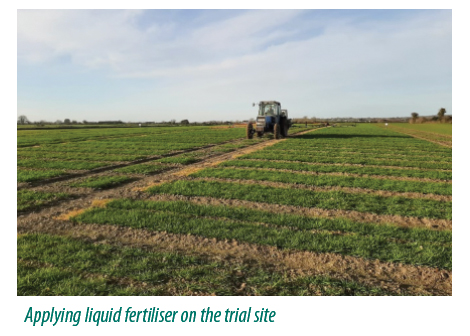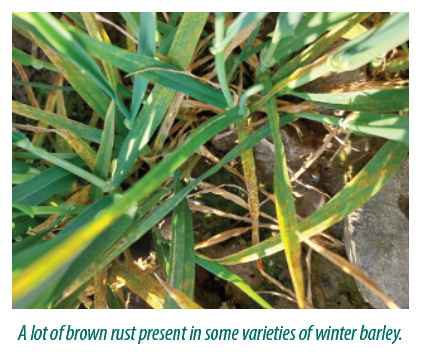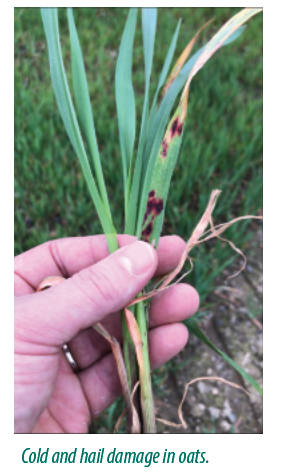WINTER WHEAT
 For low soil N indices, a three-split-N programme for winter wheat should be followed, with the first application having being applied in mid-March, main split by GS 31 (first node - which is fast approaching), and last split by GS 39 (flag-leaf fully extended). If volunteer beans are a problem, they can be controlled easily using Zypar. Apply a robust T0 programme if yellow rust is present. A strobilurin based programme partnered with a triazole will provide protectant and systemic action against yellow rust on badly effected crops. Speak to your Drummonds agronomist for further information on this. CeCeCe, Sonis and Medax Max will be the products of choice for PGR application. If lodging is a risk, use Medax Max at both T0 and T1 timings.
For low soil N indices, a three-split-N programme for winter wheat should be followed, with the first application having being applied in mid-March, main split by GS 31 (first node - which is fast approaching), and last split by GS 39 (flag-leaf fully extended). If volunteer beans are a problem, they can be controlled easily using Zypar. Apply a robust T0 programme if yellow rust is present. A strobilurin based programme partnered with a triazole will provide protectant and systemic action against yellow rust on badly effected crops. Speak to your Drummonds agronomist for further information on this. CeCeCe, Sonis and Medax Max will be the products of choice for PGR application. If lodging is a risk, use Medax Max at both T0 and T1 timings.
WINTER BARLEY
 PGR and trace elements should be applied ASAP. The next plan is to apply the main split of nitrogen by GS31 if not applied already. Crops on low indices soils requiring over 180kg/N/ha should have a three-split N programme. Aim to have all N applied by GS 32 (second node). With regards to backward crops, an application of K2/CCC before stem extension was a good boost to crops to promote tillering. As annual meadow grass has tillered, it is now too late for adequate control.
PGR and trace elements should be applied ASAP. The next plan is to apply the main split of nitrogen by GS31 if not applied already. Crops on low indices soils requiring over 180kg/N/ha should have a three-split N programme. Aim to have all N applied by GS 32 (second node). With regards to backward crops, an application of K2/CCC before stem extension was a good boost to crops to promote tillering. As annual meadow grass has tillered, it is now too late for adequate control.
WINTER OATS
 Winter Oats have shown strong growth to date. Nutrition can be delayed on thriving crops to make the best use of available soil resources. Black spots are present on leaves, a sign of cold stress as there have been fluctuating temperatures into the last week of March. This will not significantly affect plant performance. Oats have a high K requirement due to the vast amount of straw they produce. 110 units/acre of K will be needed. Aim to apply PGR at GS 31.
Winter Oats have shown strong growth to date. Nutrition can be delayed on thriving crops to make the best use of available soil resources. Black spots are present on leaves, a sign of cold stress as there have been fluctuating temperatures into the last week of March. This will not significantly affect plant performance. Oats have a high K requirement due to the vast amount of straw they produce. 110 units/acre of K will be needed. Aim to apply PGR at GS 31.
Nitrogen applications on oats (index 1 = 165kg/N/ha) will be completed soon, with a 50:50 split at GS30 and GS32. If greater yields of 7.5t/ha are expected, add 20kg/N/ha for each t/ha yield increase.
SPRING BEANS
Weed control should be completed pre-emergence with beans. Beans compete poorly with weeds in their early life, so a robust weed control programme is necessary. If weeds become prominent in the crop, it will also cause harvesting difficulties later. A firm, fine seedbed free of clods will give the best chance of residual herbicides controlling weeds. Field history will determine what products to use. Sowing rates for beans will be determined by thousand grain weight. Aim for 30-35 plants/m2. As the yield potential of spring beans decreases after the first week of April, it is important to prioritise beans before the likes of barley or spring rape.

